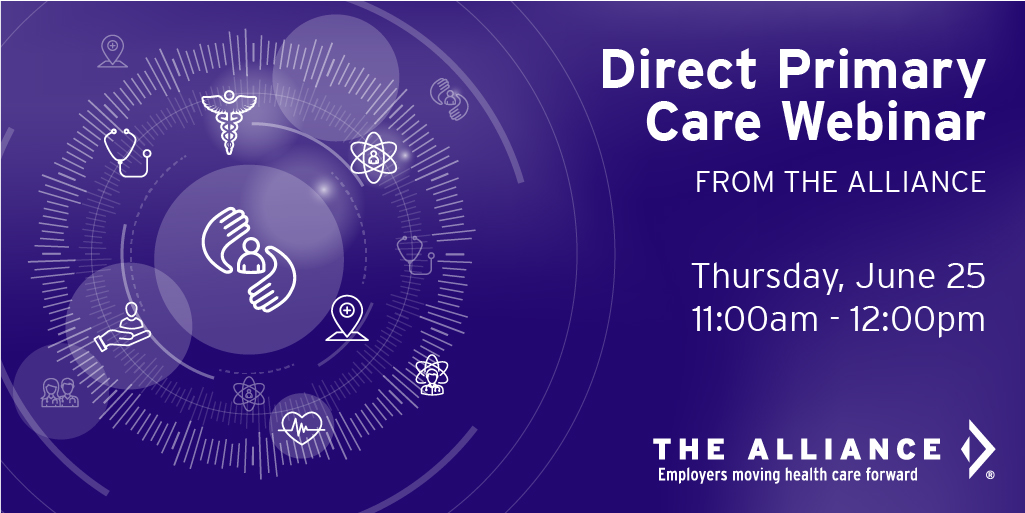
Direct Primary Care Webinar Part 2 Recap
Lately, many of our self-funding members have expressed interest in starting an on-site clinic or joining a shared-site clinic that delivers Direct Primary Care. After all, Direct Primary Care has become an increasingly hot topic during the pandemic due to its monthly, per-patient payment method that lowers overall costs, and the emphasis it places on increased primary care access – like same-day appointments and telehealth services.
The increased attention towards Direct Primary Care clinics has also grown since The Alliance announced the opening of our own Sun Prairie clinic in fall 2020. Given this, we want to provide our members with information to address any questions they may have, and who better to answer them than fellow employers of The Alliance cooperative? Dan Ludwig of Brakebush. External Link. Opens in new window. Brothers, Inc., Tena Hoag of Advanced Laser. External Link. Opens in new window., and Jake Nolin of Rice Lake Weighing Systems. External Link. Opens in new window., all graciously accepted our invitation to share their successes in establishing or joining clinics of their own.
Employer Q&A
“Why did you start an on-site clinic?”
Jake Nolin: We had an ongoing health center strategy we’d been discussing for years, but what ultimately pushed us was facing down a 30% renewal increase – the equivalent of an additional $2 million per year – five years ago. We’re now 3.5 years into our clinic, and our health center is the focal point of our health strategy – it links everything together from being self-insured to benefit plan design, to steerage all the way down to contracted care, which we receive through The Alliance.
Tena Hoag: We felt like we were being taken advantage of and we knew we could provide primary care for less by opening our own clinic.
Dan Ludwig: We were also, year after year, facing double-digit premium increases while fully insured, so in 2014 we took control of it as part of a self-funded platform. Prior to 2017, we provided a musculoskeletal injury prevention program and that had great success. We thought, “if we can have success providing on-site services for soft-tissue injuries we can probably have additional success looking at primary care.” So we expanded our services to provide those on-site in 2016.
How did you get past any internal hurdles of moving to a self-funded clinic?
Dan: The biggest internal hurdle is obviously assuming the cost, but with the substantial increases we’d experienced and the new ones we were facing, our leadership was ripe for change. They recognized we couldn’t continue to do things the way we were. The cost of the clinic compared to the expected return made the ‘sell’ a lot easier.
Tena: Our ownership wanted to take care of the employees, and some felt that going down the on-site clinic path was “getting up in people’s business” and that’s certainly not who we were. So there was some difficulty selling that internally, but we knew the cultural shift would be a multi-year buy-in.
Jake: Our internal hurdle at the time was our President. We’re privately held and have a passion for taking care of our employees. He wanted something approximating old-fashioned health care where your provider knew you and spent more than 10 minutes with you. Getting a commitment for five or more years is a big commitment – it’s a big investment of money and time to put a clinic together. You need to be committed. If your CEO is a one-and-done type and won’t follow through after a bad year, and pulls the plug at the one-year mark, don’t even bother. It has to be seen as a long-term investment.
“How did you choose your provider/partner?”
Jake: That’s been a journey for us. We interviewed a number of different 3rd party providers and started with CareHere. External Link. Opens in new window.. They had 300 clinics around the country. We assumed that bigger was better. As it turned out, that didn’t work well for us because we wanted to do things like childhood immunizations and other things weren’t under their boilerplate. Last year we went to NeoPath Health out of Minneapolis, and they’re much smaller regionally as a 3rd party clinic provider. They have 10 sites in Minnesota. They understand us and listen to us when we say “we want to do this in our health center” and they want to make it happen. It’s been like a night-and-day difference.
Dan: Our original partner was handed the business because we had a long-term relationship with them from our wellness program. After about a year we discovered they had somewhat of a boilerplate of “this is what we offer in a clinic” and we wanted to be able to offer other things to our employees. I would encourage anyone going into a clinic is asking what they offer when developing your RFP, and ask if they’re comfortable with offering a particular service in your clinic. We selected ProactiveMD on March 1st, which is an interesting timeline because COVID-19 hit right as they were taking over. There’s been a very steep learning curve and we’ve gotten to know each other very quickly due to the pandemic. Overall, it’s been very positive.
Tena: 2-3 years ago, when we started down this path – we’re a small employer – we had about 100 employees and 65 of them were on our health plan. We didn’t have all the same options as our larger local businesses, so we interviewed some independent operations, but with our size and with our limited budget, we ultimately ended up in a shared-site clinic situation. In total, three local businesses that opened our clinic together. It’s a very different model, but that underscores the fact that you do have power – regardless of your size – you just need to find like-minded people to help take advantage.
“Are you being billed as fee-for-service or one monthly fee that includes all monthly visits, or PEPM (Per employee, per month) payment methods?”
Dan: Ours is a set monthly fee that covers the vast majority of services. Things that would be additional are higher-cost labs and some prescription drugs – everything else is 100% covered. All employees, regardless of whether or not they take our coverage, and all covered spouses and dependents can use our clinic. Our goal is to have everything free at the clinic. We do have about 10% of employees who choose an HDHP and the IRS gets their say to decide what we’re allowed to give for free, but we keep those costs as low as humanly possible.
Tena: Our shared-site situation is a bit different. The group shares a certain number of hours per week for the various services the clinic offers. We are often charged for our share of hours whether we actually use them or not. Excess capacity hours are split by a prearranged percentage that our group originally agreed upon.
Jake: Our clinic is private to our employees and family members on our “Take Control of Your Health” plan. There’s zero charge for anything at our health center. From prescriptions to procedures to wellness visits and referrals, nothing has a cost and it’s all pass-through, which means we pay an administrative fee and all costs are transparent and passed through to us. They pay them, and we reimburse them. We pay for everything down to the internet and salaries of six full-time employees.
How did you onboard different vendors?
Jake: It’s kind of like onboarding a new staff member. It’s really important for them to understand your goals; they have to understand the benefits. For all of our providers, they have all come from large health care systems so they understand how those systems work and how our systems are different, so we just had to explain our system and what we wanted to achieve. We had to ask them how they refer. And it’s important for them to understand our tiered plan design, so if they refer someone to tier one that person pays nothing, but if they refer to tier two or three, they are economically impacting our plan and our members. It took a lot of education, they don’t just pick up the plan design, and all the partners and lingo on the first go-round, but I remind them about it every quarter and align with them on a regular basis, and they’ve become subject matter experts.
We also use a Care Navigation Firm called Alithius. External Link. Opens in new window. in conjunction with The Alliance’s data, who is also well connected with our on-site clinic. All of our referrals go through Alithius and they provide different options for Tiers 1-3, both 1 and 2 are both provided through The Alliance and tier 3 is our old PPO plan, so Alithius is helping us with consumer education, and telling employees their options and they will direct them to a good decision whether it’s location or provider system that matters to them, they can have the information that they need to make a good decision. Well over 95% of our members are choosing Tiers 1-2 but Tier 3 accounts for 65% of our spend.
Tena: Ultimately, we did not end up going with an independent operation, we are actually with a health system. It has worked out well for us so far. They’ve been very receptive to the vast majority of everything we’ve brought to them. We’ve found out to just ask. Just ask. Ask them how they can help us help our employees. There were a fair amount of bumps and bruises in the beginning but that has pretty well settled out. There are a lot more details that folks maybe don’t realize matter. It’s quite a process, it’s a journey, and I don’t think we’ll never be done making tweaks and improvements, but the important thing is to find someone who has flexibility and a willingness to be in it for the right reasons.
Tena, you have a shared-site clinic, so how did you all get together to create the clinic?
Tena: We had some local people to help make us smarter faster, we’ll call them circles of influence, and if your inquisitive and innovative connections start happening from there. That’s how I was introduced to a lot of different providers. This may sound simple, but we’ve found that the other businesses, by simply being involved in our community and attending chamber events or attending speaker meetings, you meet others who care about the same things that you care about. Then it grows from there. We connected with Spectrum industries and found out we were researching the same things at the same time, and we started a friendly relationship. Then when we were ultimately vetting out providers, another business in our area, Great Northern, was looking to add to their Chippewa Falls location as well. I’m very pleased with the businesses we’ve been able to partner with so far.
What services do you offer at your clinic?
Jake: Our clinic is actually a near-site clinic, and It’s about a mile from our facility. We bought a dental office that was available and retrofitted it into a 3200 square-foot clinic. We wanted everyone to have access to it, and it was also a timing thing – we didn’t have a lot of available space on our campus and we wanted to do it the right way. We didn’t want to shove people in a closet or a trailer, and in hindsight it’s worked out tremendously well; it gives people a sense of privacy when they get help and it keeps family from visiting employees while they’re at work. I like it and we think it’s worth a few minutes of inconvenience.
As far as our services go, we do primary care, acute care (stitches and getting particulates out of the eye), and chronic disease is a very big thing. When we went through the COVID-19 lull we went from 85% to 35% utilization. We used that time to do a lot of telephonic contact with people who have chronic diseases because wellness is huge for us. Even if an employee has just one appointment a year and it’s a physical, we reward them for it. We have a 125-drug formulary dispensary in our clinic, so lots of prescriptions can be picked up at no cost. We’re fortunate to have an NP and an MD who will both do in-office procedures. They’ll do injections, remove skin tags, things that would cost thousands at Marshfield or Mayo, and obviously they do referrals for medical and mental health. We do pre-employment drug screens and physicals, but we do not do Op-med. or workers comp. That’s separate.
Tena: We have a PA who does all our normal primary care things. We also offer physical therapy which has become one of the most popular facets of the entire program. He does work both at the clinic as well as on-site. We just wove behavioral health into the contract in 2020, so now it’s really a one-stop shop for any physical or mental needs.
Dan: Medically we offer primary care, urgent care, chronic disease management, labs, an on-site dispensary, and a robust muscular-skeletal program; they’re out in the plant looking at things from an ergonomic standpoint and doing employee surveys, looking for problem areas, and seeing if it’s an environmental issue or individual anomaly and trying to catch it early on before it progresses into something more severe. Of course, they do other things like physical therapy and rehab when we have an actual injury. We also bring an on-site orthopedic surgeon once a month who can do pre- and post-op consultations and injections. We just started with mental health at the beginning of the year, and it took off more so than we expected. It didn’t take long before people were utilizing that. We have a chaplaincy program here as well. We have on-site mammograms which is a mobile service, and we have at-home sleep study devices we can send people home with as well. We have a wide range of services we can keep in-house and last year we started doing on-site imaging with x-rays and ultrasounds with a mobile van who responds quite quickly to urgent care situations – oftentimes in an hour. And when you consider the alternative to driving 20 minutes to the nearest ER and waiting in the waiting room, sometimes it’s actually faster.
How is your clinic connected to local providers?
Dan: We tell people if they have an existing relationship, that they don’t need to drop their doctor to use ours. They can use us within whatever fashion you’re comfortable with. If they only want to use us for urgent care? That’s fine. It comes down to individual choice. You have some people that use us as their medical home and some people that have been with their doctor for X number of years and really like them.
Jake: Almost everybody has migrated to our health center because we have a female DMP and a male MD. In relationship to the community, we have an imaging partner and PT partner that The Alliance assumed the contracts for, and that’s remained very strong. They do direct referrals. We are in a community within Marshfield and Mayo territory, and in the beginning they were very difficult in getting files transferred and recognizing us as a legitimate medical provider, but we’ve seemingly worked through that.
Through this experience what do you think your savings have been to overall health care spend?
Jake: I would say over 3.5 years we’re approaching 10 million dollars in savings. We have not had an employee contribution increase in five years. All our savings include the costs of the clinic. I would estimate that every dollar we spend on the clinic we get two back, which is pretty substantial.
Tena: I can’t give you a long-term estimate in what we’re catching and preventing from happening. But I can say our savings are roughly $5,000 a month in terms of what our care is at the clinic vs. what it would be somewhere else. And keep in mind our total spend is less than a million dollars. The thing that makes me happiest about that, is that’s $60,000 that’s not coming out of the pocketbooks of our employees and that makes us feel good.
Dan: That’s been one of our struggles figuring out what exactly what is our total savings? Some of it’s easy, but the unnecessary fee-for-service referrals that we no longer have has been difficult to capture in terms of calculating savings. We’re preventing things. We have some conservative estimates, but one thing that’s very clear is we’ve experienced a savings every year since opening a clinic – even including the costs to run it. It’s about a 2-to-1 ratio in clinic costs which is substantial.
What’s Next?
- This blog recaps our June 25th webinar: Direct Primary Care Part 2: Employer Q&A. If you missed Part 1 of our Direct Primary Care webinar series on June 8th, which hosted doctors of Direct Primary Care clinics who discussed their ever-increasing importance to plan participants and employer health costs, you can view the recording. External Link. Opens in new window. or read the recap.
- There are more questions (and employer answers!) than what’s included here. To watch the webinar in its entirety you can view the recording here.. External Link. Opens in new window.








